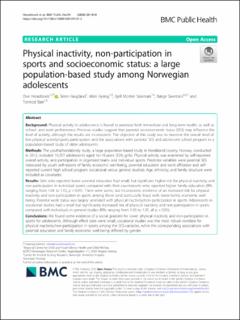| dc.description.abstract | Background
Physical activity in adolescence is found to promote both immediate and long-term health, as well as school- and work performance. Previous studies suggest that parental socioeconomic status (SES) may influence the level of activity, although the results are inconsistent. The objective of this study was to examine the overall level of low physical activity/sports participation and the associations with parental SES and adolescent school program in a population-based study of older adolescents.
Methods
The youth@hordalandy study, a large population-based study in Hordaland county, Norway, conducted in 2012, included 10,257 adolescents aged 16–19 years (53% girls). Physical activity was examined by self-reported overall activity, and participation in organized team- and individual sports. Predictor variables were parental SES measured by youth self-reports of family economic well-being, parental education and work affiliation and self-reported current high school program (vocational versus general studies). Age, ethnicity, and family structure were included as covariates.
Results
Girls who reported lower parental education had small, but significant higher risk for physical inactivity and non-participation in individual sports compared with their counterparts who reported higher family education (RRs ranging from 1.04 to 1.12, p < 0.01). There were some, but inconsistent, evidence of an increased risk for physical inactivity and non-participation in sports among those (and particularly boys) with lower family economic well-being. Parental work status was largely unrelated with physical inactivity/non-participation in sports. Adolescents in vocational studies had a small but significantly increased risk of physical inactivity and non-participation in sports compared with individuals in general studies (RRs ranging from 1.03 to 1.05, all p < 0.05).
Conclusions
We found some evidence of a social gradient for lower physical inactivity and non-participation in sports for adolescents. Although effect sizes were small, vocational studies was the most robust correlate for physical inactivity/non-participation in sports among the SES-variables, while the corresponding associations with parental education and family economic well-being differed by gender. | en_US |

